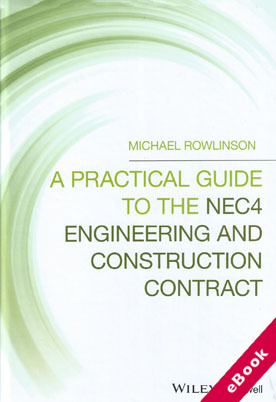A Practical Guide to the NEC4 Engineering and Construction Contract (eBook)
ISBN13: 9781119522546
Published: November 2018
Publisher: Wiley-Blackwell
Country of Publication: UK
Format: eBook
(ePub)
Price: Out of print
The amount of VAT charged may change depending on your location of use.
The sale of some eBooks are restricted to certain countries. To alert you to such restrictions, please select the country of the billing address of your credit or debit card you wish to use for payment.
Sale prohibited in
Korea, [North] Democratic Peoples Republic Of
Due to publisher restrictions, international orders for ebooks may need to be confirmed by our staff during shop opening hours. Our trading hours are Monday to Friday, 8.30am to 5.00pm, London, UK time.
The device(s) you use to access the eBook content must be authorized with an Adobe ID before you download the product otherwise it will fail to register correctly.
For further information see https://www.wildy.com/ebook-formats
Once the order is confirmed an automated e-mail will be sent to you to allow you to download the eBook.
All eBooks are supplied firm sale and cannot be returned. If you believe there is a fault with your eBook
then contact us on
ebooks@wildy.com and we will help in resolving the issue. This does
not affect your statutory rights.
This eBook is available in the following formats: ePub.
Need help with
ebook formats?
Inside A Practical Guide to the NEC4 Engineering and Construction Contract, readers will find chapters on the background of the NECECC; contract data and other documents; the‘spirit of mutual trust’; all of the individuals involved in the process (eg: project managers, clients, supervisors, subcontractors, etc.); communication issues, early warnings and other matters; quality management; titles; dealing with timing; payment processes; cost components; compensation procedures and assessments; dealing with terminations; dispute resolution; completing the contract and more.
- A practical guide to the application of the procedures contained in the newly issued NEC4 Engineering and Construction Contract
- Provides detailed guidance on the use of the agreement, which is claimed to offer increased flexibility, improved clarity and greater ease of use
- Written specifically for people actually using and administering the NEC contracts
- Features 3 appendixes covering tables of clause numbers, case law and statutes; employer’s, project manager’s, supervisor’s, contractor’s and adjudicator’s actions; and communication forms and their uses.
First launched in 1993, the NEC has become one of the UK's leading standard forms of contract for major construction and civil engineering projects, making
A Practical Guide to the NEC4 Engineering and Construction Contract a must-have resource for any contractor using the latest version of this contract.
